Anchor - North Street / High Street / Lyndhurst Road - 1811

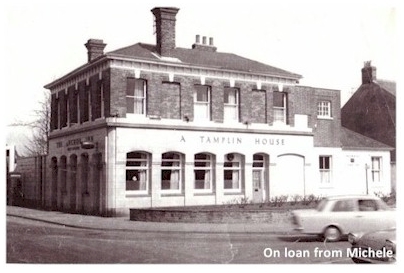
The Anchor is Worthing towns oldest still surviving pub. The current building, a rebuild, dates from around 1895. The original building goes back to at least 1805 and was a much larger structure. At that time the land included stabling and a pleasure ground with Archery and a bowling green. It is worth noting that before the days of pistols, archery practice was obligatory. Records show that it was occasionally used for coroners inquests - most notably that of smuggler William Cowerson in 1832, who was killed escaping from the customs officials of the time.
Known to many as The Anchor it was originally called The Golden Anchor. Later it became the Jack Horner, The Stage and now The Corner House.
Known to many as The Anchor it was originally called The Golden Anchor. Later it became the Jack Horner, The Stage and now The Corner House.
The name may have originated from the word 'Anker', a measure of brandy (10 gallons) and the Golden refers to its colour. Guide books at the time also refer to the poverty of Worthing where land could be purchased for as little as 'half an anker'. Lyndhurst Road was originally Anchor Lane changing in 1874.
Two brothers Tim & Mat Taylor purchased the Stage in 2015, as it was then, with plans to turn the building into a family-friendly place to eat and drink, taking advantage of the large recently extended exterior. Inside it promises to be bright and cheerful. Worthing pubs were invited around to see the work in progress.
Details of the work undertaken later on, first some history
Two brothers Tim & Mat Taylor purchased the Stage in 2015, as it was then, with plans to turn the building into a family-friendly place to eat and drink, taking advantage of the large recently extended exterior. Inside it promises to be bright and cheerful. Worthing pubs were invited around to see the work in progress.
Details of the work undertaken later on, first some history
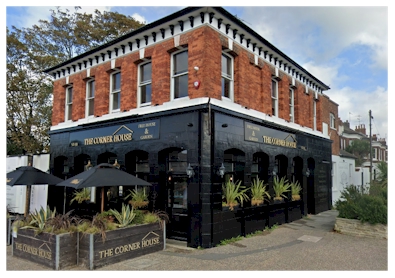
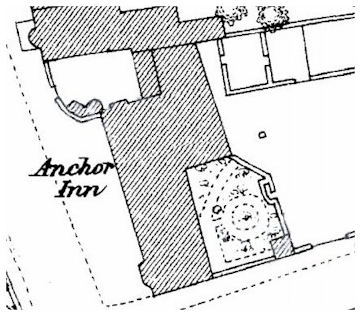
A street plan view of the Anchor in 1877, a very different building from what we see today. Top left, a gated entrance may have been stabling for guests/travellers.
An organised garden is visible with bushes and trees, a circler path and a central feature. The square block on the corner may have been a toilet, We think this was the much older original building which matches up with the one in the museum
A bay window is present on the front face which might imply the building was a knock-through of several ajoining houses.
One thing that has become quite clear, is that the large amount of room available behind the building would easily support a stable block, or as claimed in one written work, an archery practice range.
An organised garden is visible with bushes and trees, a circler path and a central feature. The square block on the corner may have been a toilet, We think this was the much older original building which matches up with the one in the museum
A bay window is present on the front face which might imply the building was a knock-through of several ajoining houses.
One thing that has become quite clear, is that the large amount of room available behind the building would easily support a stable block, or as claimed in one written work, an archery practice range.
Many years ago when I was a little bit more skilful, I studied the 1877 map and armed with some pictures of the Worthing town model in the museum I constructed this dimesioned impression of what it may have looked like at the time.
Here we can see that it was possibly three buildings in one. The upper floor made of rooms was for guest. Any building that was called an Inn, had to supply food and abed, as well as stabling.
It was ideally positioned at the top of the high street which at the time was the main entrance to Worthing town.
Here we can see that it was possibly three buildings in one. The upper floor made of rooms was for guest. Any building that was called an Inn, had to supply food and abed, as well as stabling.
It was ideally positioned at the top of the high street which at the time was the main entrance to Worthing town.
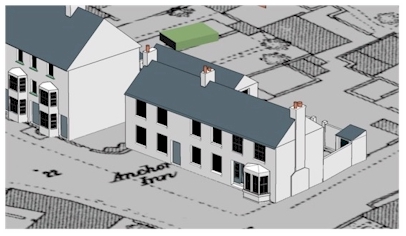
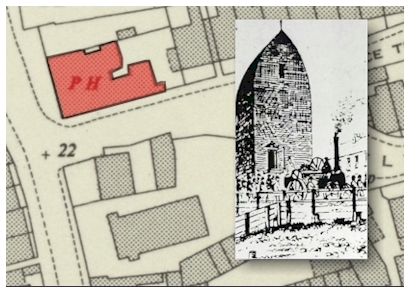
1881 locals were stunned to see a windmill sitting outside the pub where it remained for a while. The Cross Street mill was on the move to the coast from its original position close to Worthing station. The fast growth of the town with taller buildings disrupted the airflow, prompting the relocation.
The stripped body of the post mill was placed on a reinforced cart and pulled by a large number of horses in a line. It came a cropper on the corner due to physics not allowing a long line of horses to pull around a right angle.
The beasts were replaced with two traction engines to finish the job. It was moved to Sea Mill Park Crescent, hence its name. Although the map I've used for illustration is undated it does show a rebuilding phase of the pub.
The stripped body of the post mill was placed on a reinforced cart and pulled by a large number of horses in a line. It came a cropper on the corner due to physics not allowing a long line of horses to pull around a right angle.
The beasts were replaced with two traction engines to finish the job. It was moved to Sea Mill Park Crescent, hence its name. Although the map I've used for illustration is undated it does show a rebuilding phase of the pub.
The undated photograph taken from Lyndhurst Road looking west shows the Anchor on the right side and illustrares the impossble right angle that the travelling windmill was required to take.
Every building other than the pub in this image was demolished to widen the road. in fact much of this area was destroyed and opened up for redevelopment.
Fortunatly the Swan just up the road remained untouched but all the housing on the north side of the anchor disapeared and was replaced with a carpark, not for the use of the pub I hasten to add.
Every building other than the pub in this image was demolished to widen the road. in fact much of this area was destroyed and opened up for redevelopment.
Fortunatly the Swan just up the road remained untouched but all the housing on the north side of the anchor disapeared and was replaced with a carpark, not for the use of the pub I hasten to add.
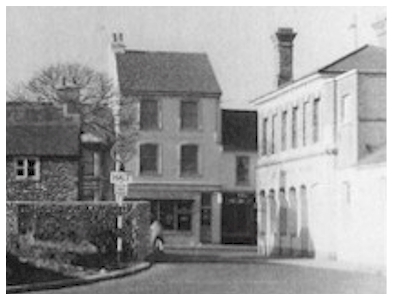
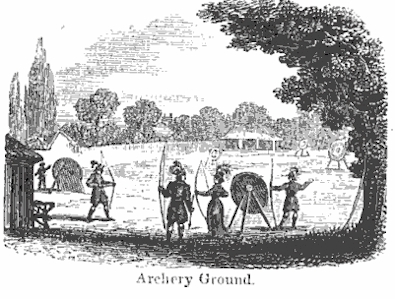
There was a guide book written in 1842 that mentions the inns and hotels of Worthing. The entry for the Anchor inn reads:
"The Anchor, High street, connected with the latter is an extensive archery ground, which receives considerable patronage. Charge for the use of bows, arrows, &c. &c and entrance, 1s. (One Shilling) It is open from 9AM to 5PM"
The article is accompanied by the picture on the right. We would like to think it is the archery ground itself.
"The Anchor, High street, connected with the latter is an extensive archery ground, which receives considerable patronage. Charge for the use of bows, arrows, &c. &c and entrance, 1s. (One Shilling) It is open from 9AM to 5PM"
The article is accompanied by the picture on the right. We would like to think it is the archery ground itself.
Lorraine Pavett, a landlady of the Jack Horner, changed the name of the pub to The Stage. This may possibly be to reflect the number of drag acts that performed there.
Chris Mellish writes: Nick Heryet (landlord) opened 'The Jack Horner' up as Worthing's first gay pub. (Although primarily a gay pub, it was open to all. My personal experience from both visiting, working and even living there can vouch that it really was a pub for everyone.)
Nick bought the pub on the 10th of August 1999 and officially opened it to the public on the 13th of August (the same day as the Solar Eclipse). He bought the lease off someone named Roger Philips.
Chris Mellish writes: Nick Heryet (landlord) opened 'The Jack Horner' up as Worthing's first gay pub. (Although primarily a gay pub, it was open to all. My personal experience from both visiting, working and even living there can vouch that it really was a pub for everyone.)
Nick bought the pub on the 10th of August 1999 and officially opened it to the public on the 13th of August (the same day as the Solar Eclipse). He bought the lease off someone named Roger Philips.
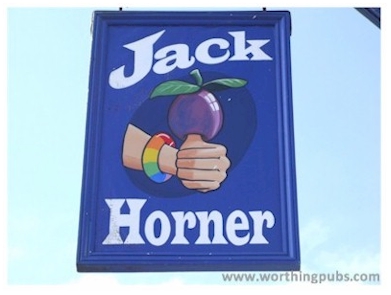
Refurbishment - The Corner House - 2015
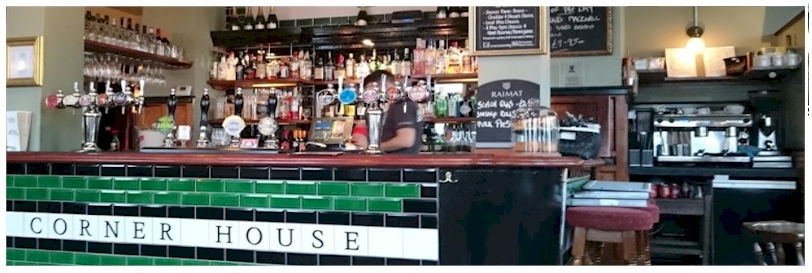
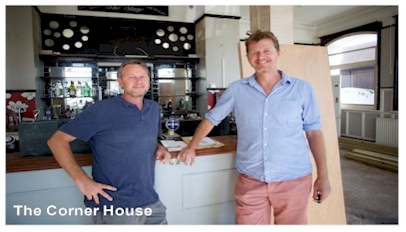

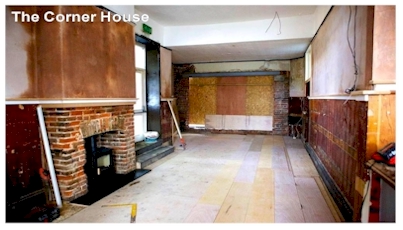
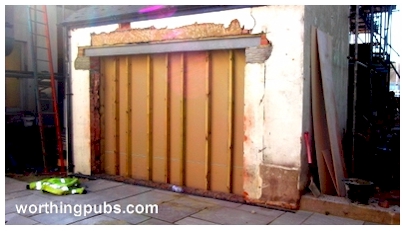
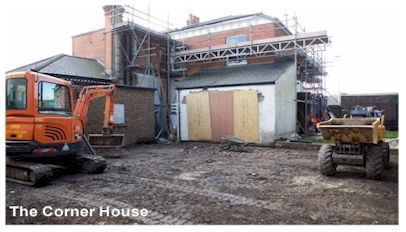
Tim & Mat Taylor wasted no time in stripping the interior back to the framework top to bottom. As well as making some structural changes.
We visited whilst the work was underway and, had a tour, including upstairs which was being changed into flats, or should I say apartments.
We had one question that we were keen to ask, where was the cellar? As far as they knew, there wasn't one. It's possible it was in a part of the building that was lost on an earlier rebuild and now rest under the garden on the north side, we'll never know.
We visited whilst the work was underway and, had a tour, including upstairs which was being changed into flats, or should I say apartments.
We had one question that we were keen to ask, where was the cellar? As far as they knew, there wasn't one. It's possible it was in a part of the building that was lost on an earlier rebuild and now rest under the garden on the north side, we'll never know.
Please bear in mind these images were taken in 2015, and like most pubs, they mature over time.
The cornerhouse now has an established reputation as a Gustropub. As far as we are aware Mat and Tim still run the place as well at thier other concern, The Beach House on the seafront.
The cornerhouse now has an established reputation as a Gustropub. As far as we are aware Mat and Tim still run the place as well at thier other concern, The Beach House on the seafront.
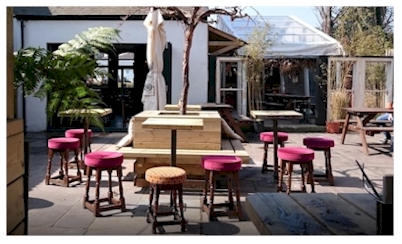
Known landlords
1832 - George White
1839 - James Carter
1850 - 51 Francis Bushby
1853 - Charles Pullen
1855 - Charles Curtis
1858 - 1866 William Cager
1891 - William Norris
1895 - G Mayhew
1899 - Joseph Moore
1905 - Maria Moore
1912 - 1932 Albert Gordon
1956 - 1960 Ernest Rofe & Winnifred Rofe
1969 - 1975 (Approx) Ralph & Jean Rogers
1978 - (Approx) Jean & Dave Bone
1986 - Andy & Di Earl
2010 - Larraine Pavett
2015 - Tim & Mat Taylor
1832 - George White
1839 - James Carter
1850 - 51 Francis Bushby
1853 - Charles Pullen
1855 - Charles Curtis
1858 - 1866 William Cager
1891 - William Norris
1895 - G Mayhew
1899 - Joseph Moore
1905 - Maria Moore
1912 - 1932 Albert Gordon
1956 - 1960 Ernest Rofe & Winnifred Rofe
1969 - 1975 (Approx) Ralph & Jean Rogers
1978 - (Approx) Jean & Dave Bone
1986 - Andy & Di Earl
2010 - Larraine Pavett
2015 - Tim & Mat Taylor
A little bit extra
1853: Charles Pullen, landlord of the Anchor Inn, High Street, appeared before Worthing magistrates charged with knowingly harbouring notoriously bad characters in his pub, namely two prostitutes, encouraged by his wife, Sarah. Superintendent Norman, chief of Worthing police, said he ejected the “ladies of the night” three times in one day. At one stage they were fighting among themselves and Mrs Pullen. Her husband said he was exposed to many temptations. He was a stranger to the town and therefore unacquainted with disorderly persons. Charles told the court he would do better in future but was fined 40s with 17s costs. A few days later he appeared in the dock again charged with beating his wife, who told magistrates: “He does ill-use me. He says I know other men, and sleep with them.” But the defendant claimed Sarah thrashed him and gave him two black eyes. Charles was sent to Petworth Gaol and replaced as landlord by Charles Curtis.
1958: A cinema styled organ was installed in the bar to entertain customers.
1853: Charles Pullen, landlord of the Anchor Inn, High Street, appeared before Worthing magistrates charged with knowingly harbouring notoriously bad characters in his pub, namely two prostitutes, encouraged by his wife, Sarah. Superintendent Norman, chief of Worthing police, said he ejected the “ladies of the night” three times in one day. At one stage they were fighting among themselves and Mrs Pullen. Her husband said he was exposed to many temptations. He was a stranger to the town and therefore unacquainted with disorderly persons. Charles told the court he would do better in future but was fined 40s with 17s costs. A few days later he appeared in the dock again charged with beating his wife, who told magistrates: “He does ill-use me. He says I know other men, and sleep with them.” But the defendant claimed Sarah thrashed him and gave him two black eyes. Charles was sent to Petworth Gaol and replaced as landlord by Charles Curtis.
1958: A cinema styled organ was installed in the bar to entertain customers.
We are not responsible for the content to any of the links